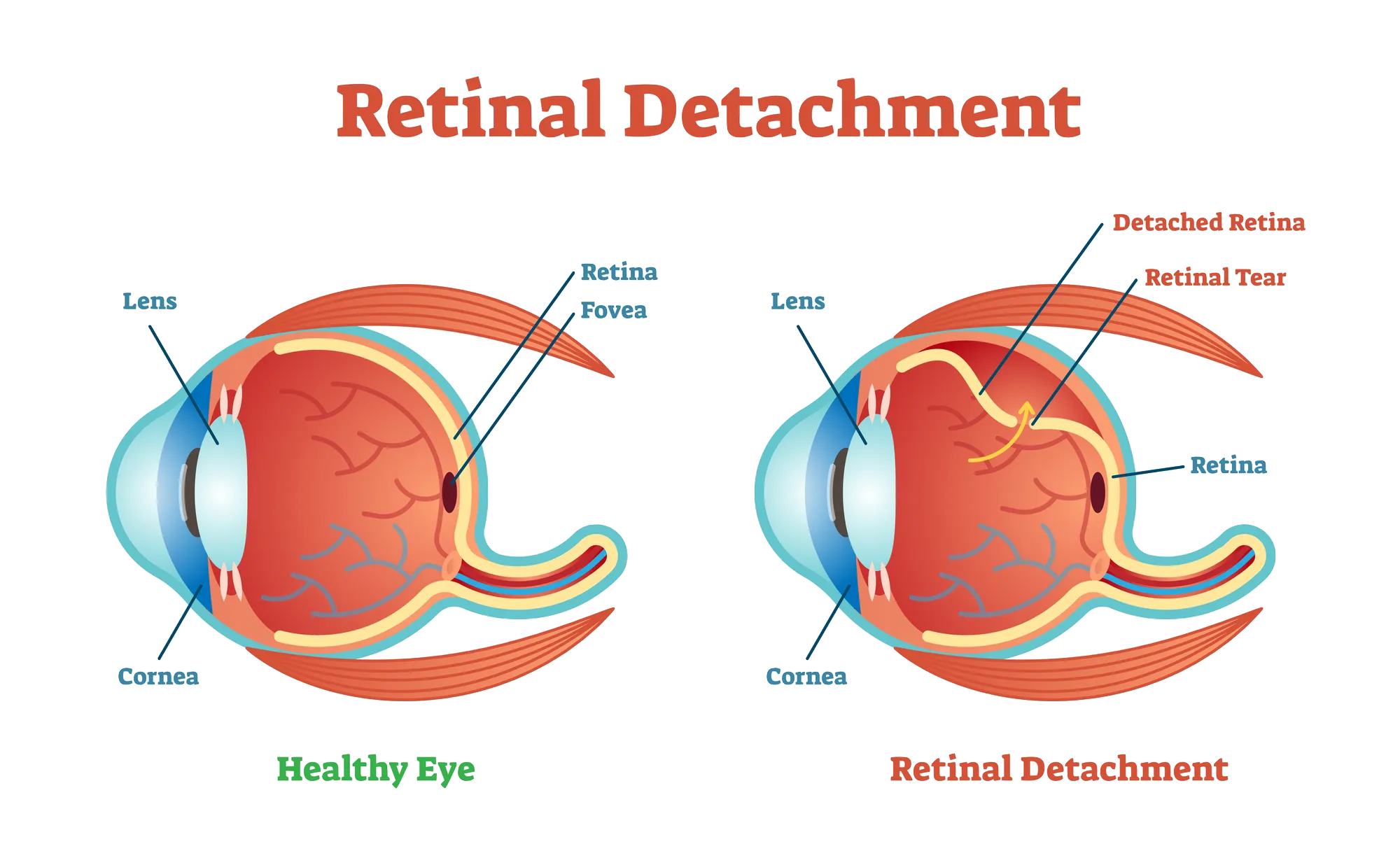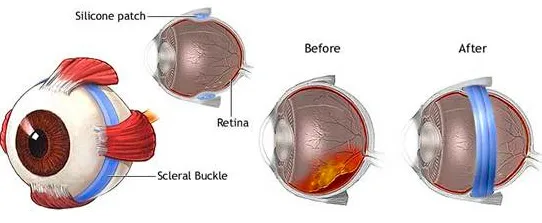
Retina is located in the posterior of the eye, a light sensitive layer of tissue. Retina is a thin layer, photosensitive which helps to create vision in a person. Tears or holes can form in the retinal tissue, creating a risk of retinal detachment and severe deterioration of vision. Retina Surgery is performed to treat this.
If there is associated vitreous hemorrhage (bleeding in the cavity of the eye) or retinal detachment, other symptoms can be seen as blurred vision or a shadow, as if curtains are closing in from the peripheral (side) vision. However, in a few cases, a retinal hole may not incur any noticeable risks or symptoms.
However, in some people who have an innately more sticky vitreous humour, as the vitreous separates from the retina, it pulls abnormally (abnormal vitreous-retinal adhesion) and causes tearing within the underlying retina. Although retinal tears may also occur because of ocular trauma, most retinal tears occur spontaneously due to PVD.
A related entity are retinal holes. The term retinal tears and holes may be used interchangeably by some retina specialists. Retinal tears develop when the vitreous pushes on the retinal walls, while retinal holes develop due to progressive thinning of the retina.


A thorough and timely examination by a retina specialist using scleral depression (applying mere pressure to the eye) and/or a 3-mirror lens is the most important step in diagnosing a retinal tear. In cases where there is limited vision or sight of the retina due to an overlying hemorrhage, ocular ultrasound may be used to aid in diagnosing a retinal tear.
1. Cryotherapy :it is the best way to treat retinal tear. If a retinal tear is diagnosed promptly before it approaches retinal detachment, the prognosis is extremely good. Retinal tears are typically treated with laser or a freezing procedure (cryotherapy). Topical or local anesthesia is applied, and the procedure is only mildly uncomfortable. The treatment creates friction around the surface of the tear that nearly removes the risk of the tear progressing to retinal detachment. After retinal tears are treated, they may develop again in future, so continue to be careful and checkup of eye should be done often.
2. Laser surgery also called photocoagulation, uses a laser beam to alter small burns around the retinal tear. The healing of cuts seals the retina to the underlying tissue, helping to prevent a retinal detachment.
Not all retinal tears require treatment. Some tears develop adhesion around the tear without treatment, and these situations can be followed without treatment.

Detached retina –a detached retina is when a thin layer of retina (back layer of your eye) gets loose and it may lead to site failure varies with the complications.
-Ophthalmological condition that involves tearing or separation of the retina.
-Three kinds of retinal detachment-
1. Rhegmatogenous
2. Tractional
3. Exudative
When we talk about its epidemiology, it is estimated to affect ~10-20 per 100000 per year. Higher incidence of rhegmatogenous Retinal Detachment in South East Asians people
Pathophysiology
1. Rhegmatogenous is the most common type of retinal detachment in occurrence. Rip and tear may lead to holes in the retinal tissue. Vitreous humour flows through disruption, underneath the retina, leading to separation of the retina and other underline layers.
2. Tractional is not caused by tear or disruption of the retinal layer, mainly occurring due to pulling away from the underlying layers.
3. Exudative, caused by an inflammation taken place underneath the retina leads to swelling and allows the retina to pull away from its layers like tumors or lesions within retinal tissue.
1. Trauma
2. Pathological myopic eye
3. Family history of retinal detachment
4. Diabetic retinopathy
5. Retinal vein occlusion
6. Corticosteroid uses
7. Metastases in the eye etc.
It's usually caused by changes in the fluid or vitreous humour inside your eye;
it changes as a person gets older, and this is called posterior vitreous detachment.
8. PVD may lead to retinal detachment and one can't avoid it from happening.
It can be caused through various reasons-
9. Short- sightedness or myopic eye.
10. Person undergone cataract surgery.
11. had an eye- injury or inflammation
12. Genetic impact, if any family member had retinal detachment
1. Floaters (dots or lines) suddenly start appearing in your foresight vision and maybe its number can go on increasing.
2. Flashes or blurred eye vision or photopsia.
3. Dark shadows around your eye vision can be seen moving.
4. May have a relative afferent pupillary defect or RAPD.
Diagnosis
a. Slit lamp examination of anterior chamber, Schaffer's sign
b. Dilated funduscopic examination
c. POCUS, optical coherence tomography
d. Decreased intraocular pressure can be observed.

1. Injecting gas or air bubbles into the eye- also called pneumatic retinopexy, the surgeon injects a bubble of air into central part of eye or vitreous cavity where bubble puts pressure on retina-containing holes against wall of the eye stopping the flow of fluid into space behind retina. Fluid under the retina is absorbed by itself and the retina can adhere to the wall of the eye. Some precautions need to be taken like patient has to keep his head in certain position for few days after surgery.
2. Indenting the surface of the eye called scleral buckling involves suturing or sewing of a silicone material to the white part of the eye called sclera, over the affected region. In this wall of the eye are indents which relieve some force caused by vitreous tugging on the retina.
In case of several holes, surgeon creates a sclera buckle that encircles entire eye like a belt.
3. Replacement of vitreous fluid in the eye called vitrectomy; the surgeon removes the vitreous along with tissue that is attached to the retina. Air or silicone oil is injected into vitreous space to help in flattened retina.
After surgery vision may take several months to improve. You may need a second surgery as well. Some person never recover all of their vision.
After surgery vision may take several months to improve. You may need a second surgery as well. Some person never recover all of their vision.

| Week-Days: | 9am - 6pm |
| Sunday: | CLOSED |
Copyright © 2022 · All Rights Reserved Bharti Eye Foundation